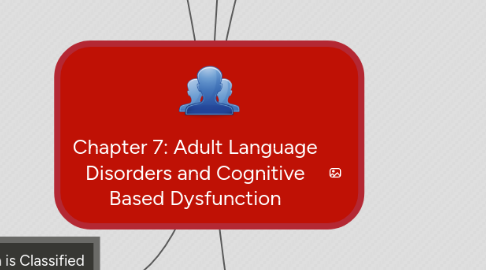
1. Aphasia
1.1. The language disorder that is acquired sometime after an individual has developed language competence.
1.2. Aphasia: disturbance in the language system after language has been established or learned, results from neurological injury to the language-dominant hemisphere of the brain, includes disturbances of receptive or expressive abilities for spoken and written language.
2. How Aphasia is Classified
2.1. Classification system
2.1.1. Taxonomy: draws upon those characteristics of Aphasia that most differentiate disorders from one another and is similar to the way we might classify automobiles
2.2. Behavioral Sysems
2.2.1. Impairments between different individuals varies
2.2.2. Some are unable to initiate speech
2.2.3. Some may be able to initiate speech but not a conversation
2.2.4. Fluency
2.2.4.1. nonluent
2.2.4.2. short, choppy phrases
2.2.4.3. slow, labored production of speech
2.2.4.4. grammatical errors
2.2.4.5. telegraphic quality
2.2.5. Motor Output
2.2.5.1. individuals with impaired motor skills may show slow and labored articulation of sounds, with some groping of the articulators as they seek accurate placement
2.2.6. Language Comprehension
2.2.6.1. auditory comprehension
2.2.6.2. ability to understand spoken language (interpreting what is heard)
2.2.6.3. Aphasia with comprehension problems is receptive aphasia
2.2.7. Repetition
2.2.7.1. ability to accurately reproduce verbal stimuli on demand
2.2.8. Naming
2.2.8.1. Anomia: "no name", word-finding problems or inability to retrieve a word
2.2.8.2. paraphasias: anomia patterns, or the type of word production errors seen in a person with aphasia, give insight in the type of aphasia (2 varieties)
2.2.8.3. phonemic paraphasia: occurs when there is a substitution or transposition of a sound
2.2.8.4. semantic paraphasia: a word is substituted, often one the is in the same category as the targeted word
2.2.9. Reading and Writing
3. What are Right-Hemisphere Dysfunction, Traumatic Brain Injury, and Dementia?
3.1. Right-Hemisphere Dysfunction
3.1.1. Characteristics
3.1.1.1. hinder functional abilities
3.1.2. Identification
3.1.2.1. requires a comprehensive speech-language assessment as part of an interdisciplinary team assessment
3.1.3. Treatment
3.1.4. results from neurological damage to the right cerebral hemisphere
3.1.5. cognitive-linguistic disorder
3.2. Traumatic Brain Injury
3.2.1. Characteristics
3.2.1.1. open-head
3.2.1.2. closed head
3.2.1.3. polytrauma
3.2.2. Identification
3.2.3. Treatment
3.2.3.1. Rancho-scale
3.2.4. neurological brain damage to the brain resulting from the impact of external forces
3.3. Dementia
3.3.1. Characteristics
3.3.1.1. Mild Dementia
3.3.1.2. Moderate dementia
3.3.1.3. Severe Dementia
3.3.2. Identification
3.3.3. Treatment
3.3.4. chronic and progressive decline in memory, cognition, language, and personality resulting from CNS dysfunction
4. Defining Characteristics of Aphasia Syndromes
4.1. Broca's Aphasia
4.1.1. Fluency and Motor Output
4.1.1.1. slowed, halting, and labored speech
4.1.1.2. decreased phrase length affecting melody of speech
4.1.2. Language Comprehension
4.1.2.1. Can follow simple but not complex directions
4.1.3. Repetition
4.1.4. Naming
4.1.5. Reading and Writing
4.1.5.1. Macrographia: oversized printing
4.1.6. Damage to the frontal lobe of the brain, orchestrates motor movements for speech
4.2. Transcortical Motor Aphasia
4.2.1. Damage to the anterior and superior portions of the frontal lobe
4.2.2. characterized by nonfluent, expressive, and motor in its typology
4.2.3. individuals have repetition skills that are far better than their spontaneous speech
4.3. Global Aphasia
4.3.1. result of a large region of the brain damage or multiple sites of brain injury in the language-dominant hemisphere
4.3.2. comprehension impaired
4.4. Wernicke's Aphasia
4.4.1. Fluency and Motor Output
4.4.1.1. produces spontaneous speech that flows well with normal prosody
4.4.1.2. prosody: melody, intonation, and rhythm of speech
4.4.1.3. Logorrhea: talking excessively
4.4.1.4. Neologisms: use of made up words
4.4.1.5. Jargon: use of real words put together without any meaning
4.4.2. Language Comprehension
4.4.2.1. difficulty in interpreting verbal and written messages
4.4.3. Repetition
4.4.4. Naming
4.4.4.1. Circumlocution: talking around a word that cannot be retrieved
4.4.5. Reading and Writing
4.4.6. brain injury to superior and posterior regions of the temporal lobe, possibly in the parietal lobe
4.5. Transcortical Sensory Aphasia
4.5.1. results from damage to the language- dominant hemisphere at the border of the temporal and occipital lobes
4.5.2. echolalia: frequently repeat auditory stimuli
4.6. Conduction Aphasia
4.6.1. Fluency and Motor Output
4.6.2. Language Comprehension
4.6.3. Repetition
4.6.4. Naming
4.6.5. Reading and Writing
4.6.6. results from injury to the temproal-parietal region of the brain, typically to a connecting pathway called the arcuate fasciculus
4.7. Anomic Aphasia
4.7.1. fluent and expressive with relatively few deficits in language expression and comprehension with the exception of naming
4.7.2. impairment in word-retrieval skills in both spoken and written language
5. How is Aphasia Identified and Treated?
5.1. Assessment Process
5.1.1. Is aphasia present?
5.1.2. If so, what type or syndrome of Aphasia is indicated by the symptoms and the site of injury?
5.1.3. What treatment plan will be most beneficial?
5.1.4. What is the prognosis for recovery?
5.1.5. Are any referrals to other professionals needed?
5.1.6. Spontaneous recovery: natural healing of the brain without therapeutic interventons
5.2. Prognostic Indicators
5.2.1. variables that assist in predicting recovery: the site of brain injury, the type and the size of the injury, the type and severity of aphasia, handedness, age, preinjury health, and motivation for treatment.
5.3. Designing Treatment Plans
5.3.1. Working with Culturally and Linguistically Diverse Clients
5.3.1.1. Parallel impairment
5.3.1.1.1. with both languages demonstrating similar strengths and weaknesses
5.3.1.2. Differential Impairment
5.3.1.2.1. with one language showing greater impairment than another
5.3.1.3. Differential aphasia
5.3.1.3.1. with varying aphasia symptoms or profiles between languages
5.3.1.4. blended impairment
5.3.1.4.1. with the individual appearing to mix features of the languages
5.3.1.5. selective aphasia
5.3.1.5.1. with only one language revealing deficits and the other being preserved
5.3.2. evidence-based practice: giving special consideration to those interventions that have been studied in a controlled manner and demonstrate improvement for a particular disorder
